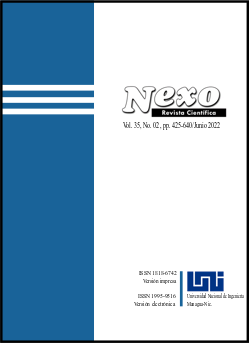The basics for choosing energy-efficient working tools of tillage machines
DOI:
https://doi.org/10.5377/nexo.v35i02.14626Keywords:
Tillage, Energy efficiency, Efficiency and quality evaluation criteria, Tillage working tools, Comparative energy evaluationAbstract
Improving the efficiency of technological tillage methods is primarily associated with developing existing tools and creating new types of working tools for tillage machines. Tillage efficiency improvement depends on the correct choice of the most energy-efficient working tools belonging to the same class of the technological process. This research aims to develop scientific baselines for choosing energy-efficient working tools of different structural designs based on the criteria of power consumption and quality of shallow tillage. The object of this research includes working tools for shallow and deep tillage. The research subject is the changes in the criteria chosen to evaluate the working tools’ efficiency. We involved mathematical modeling based on laws of science observed during tillage, carried out experiments and analyses, and summarised the experimental findings. The scientific novelty of this research justifies the criteria for evaluating the efficiency and quality of working tools used for shallow and deep tillage. The research relies on graphical and empirical dependencies describing the trends in efficiency evaluation criteria for tillage working tools with various operation speed modes. We discovered that to evaluate the efficiency and choose the most energy-efficient tillage working tool, one should use a system of criteria: specific tractive resistance of the active frontal area, terra-dynamic resistance coefficient, and the primary tillage quality parameters. The probability of compliance of the mean values of calculated and experimental findings (0.51–0.87) confirms the adequacy of proposed mathematical models describing changes in specific tractive resistance per unit of active frontal area and terra-dynamic resistance coefficient of tillage working tools. According to the research, when a more energy-efficient tillage working tool is chosen, the working tools under comparison belong to the same class of working tools based on the technological process principle and functioning conditions. Discovered trends in the changes in the efficiency evaluation criteria and the choice of energy-efficient tillage working tools for shallow and deep tillage are represented by empirical dependencies applicable in specific ranges of motion speed under certain functioning conditions. Consequently, we emphasized that further studies should justify the upper and the lower borders of the tillage working tools and terra-dynamic resistance coefficient in accordance with the agrotechnical quality indicators of tillage.
Downloads
1556
Downloads
Published
How to Cite
Issue
Section
License
Copyright (c) 2022 Universidad Nacional de Ingeniería

This work is licensed under a Creative Commons Attribution 4.0 International License.
The authors who publish in Nexo Scientific Journal agree to the following terms:
- Authors retain the copyright and grant the journal the right of the first publication under the license Creative Commons Attribution License, which allows others to share the work with a recognition of the authorship of the work and the initial publication in Nexo Scientific Journal.
- Authors may separately establish additional agreements for the non-exclusive distribution of the version of the work published in the journal (for example, in an institutional repository or a book), with the recognition of the initial publication in Nexo Scientific Journal.
- Authors are allowed and encouraged to disseminate their works electronically (for example, in institutional repositories or in their own website) before and during the submission process, as it can lead to productive exchanges, as well as earlier and greater citation of published works.










